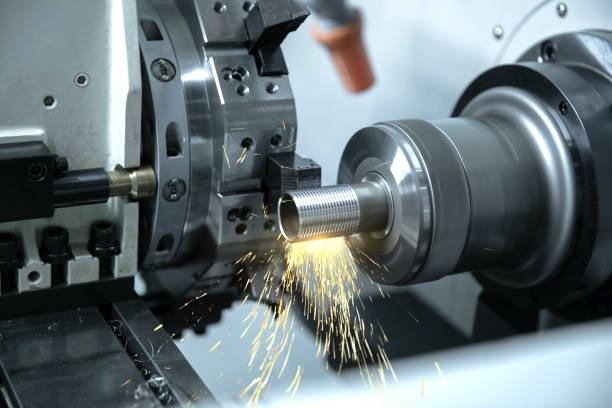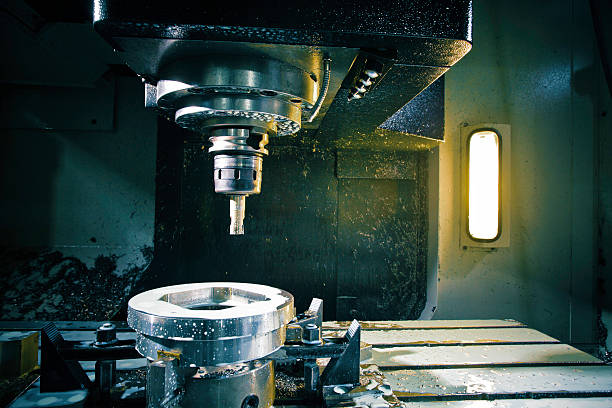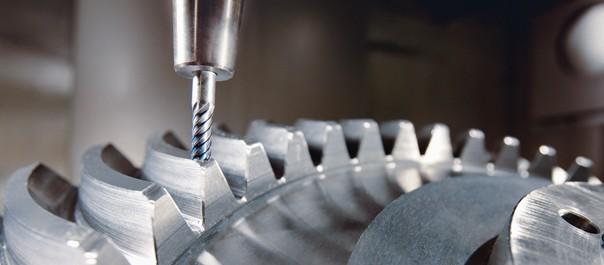
CNC Machining, which uses programmed machines to create one-of-a-kind components, is a contemporary cornerstone of the production process.
Most machining activities, such as coolant temperature, spindle speed, and more, may be managed using computer numerical control (CNC) algorithms and software. This raw material is most often referred to as a blank or workpiece. Metals, polymers, wood, glass, and composites are some of the many materials that may benefit from the layer-by-layer removal procedure.
Almost every industry that produces components for various purposes uses CNC machines, which are programmed machines capable of doing CNC machining jobs automatically. CNC machines produce high-precision components that are both affordable and very exact, opening up a wide variety of possible uses.
Inputting 3D data into a computer that runs software that controls the action of the cutting machine tools is a modern CNC machining technology. However, the machining techniques employed in CNC machining date originally from the latter years of the 20th century.
Present-day CNC machines implement processes based on a numerical control (NC) system pioneered in the metal sector in the late 1940s. The NC system used paper punch-tape applications (G-codes) to encode manufacturing process instructions. Over the subsequent fifteen years, more complex programs emerged, and by the late 1960s, the precursors to the modern CNC systems in widespread use today had emerged.
Precision, automation, and rapid production are just some of CNC Machining's many benefits. As a result, turnaround times are reduced, quality is better managed, fewer equipment is needed to get the job done, and overall capabilities are improved. Without the development of NC machining and the methods it exploited, the basis for CNC machining would not have been built. In today's competitive market, the advantages that manufacturers may provide thanks to CNC machining are directly proportional to the prevalence of NC machining.

CNC machining revolutionized manufacturing, becoming a cornerstone in large-scale and small-scale production. Its impact is profound, providing unmatched precision, speed, and automation. As technology progresses, the capabilities of CNC machines evolve, offering more sophisticated solutions every year. Understanding the fundamentals of CNC machining is crucial, as these principles apply across various types of CNC equipment, enhancing their adaptability and functionality.
Key attributes of CNC include enhanced speed, automation, and accuracy, which are fundamental to its operation. The flexibility of CNC machines is noteworthy, thanks to their program-based operation. This allows operators to manage different workpieces simultaneously, even as they tackle other tasks. Once a program is tested and confirmed for a specific project, it can be easily reused for similar future tasks. The ease of setting up and operating CNC machines contributes to swift project completion, a significant advantage in time-sensitive situations.
A defining feature of CNC machines is their ability to move in multiple directions or axes. These axes, which can be linear or rotary, are positioned with high precision and can be controlled automatically. The programmed motions in CNC machines include rapid, linear, and circular movements, with the extent and speed of these movements being computer-regulated.
Understanding the machine's available motion directions (axes) for CNC programming is vital. Different letter addresses, like X, Y, Z, U, V, and W for linear movements and A, B, and C for rotary movements designate these axes. These axes' specific names and functions can vary depending on the CNC machine type.
Programs in CNC machining are composed of various commands, which in turn consist of 'words'. Each word pairs a letter address with a numeric value, where the letter signifies the type of command or action to be performed. However, it's important to note that CNC control manufacturers may have different conventions for these letter addresses and their corresponding actions. Therefore, new CNC programmers are advised to consult the programming manuals provided by the machine manufacturer to understand their machine's specific terminology and functions.
Here's an overview of some common word types in CNC programming, along with their usual letter address designations:
● O: Program number used for identifying the program.
● N: Serial number applied for line identification within the program.
● G: Preparation function, a command that prepares the machine for a specific operation.
● X, Y, Z: Designations for the respective X, Y, and Z axes.
● R: Radius designation for specifying radii.
● F: Feed rate, governing the tool's or workpiece movement speed.
● S: Spindle speed, controlling the rotation speed of the spindle.
● H: Tool length offset used to adjust the tool length.
● D: Tool radius offset for adjusting the tool radius.
● T: Tool designation, identifying a specific tool.
● M: Miscellaneous functions, a category for various additional commands.
The endpoint is defined in degrees rather than linear measurements like inches or millimeters for rotary axis movements. These rotary axes still use letter addresses, often A, B, or C, to specify the particular axis being controlled.
While there are likely more varieties of motion available on your CNC machine than we'll cover here, these are the ones that will be present in almost any CNC machine. After briefly discussing the three distinct kinds of motion, we'll demonstrate an example program that includes each.
Rapid motion, also known as positioning in the realm of CNC machining, is a pivotal aspect that defines the efficiency and precision of the CNC process. Understanding rapid motion is crucial for anyone delving into the technicalities of CNC programming and operation.
At its core, rapid motion refers to the movement of the tool or machine component from one point to another at the highest possible speed that the machine allows. This movement is not part of the actual cutting process. Still, it is essential to position the tool or workpiece to start the machining operation or to move to a new location after completing a task. Rapid motion is pivotal for reducing non-productive time, thus enhancing overall production efficiency.
Unlike the controlled, precise movements used in cutting, drilling, or milling, rapid motion is all about speed. The primary objective here is to minimize the time spent moving between points, which doesn't contribute directly to the machining of the part. This efficiency is crucial in high-volume production environments, where even small time savings per part can significantly improve overall throughput.
Regarding programming, rapid motion is often commanded in a CNC program using a specific code, commonly called the G-code. For example, G00 in most CNC systems instructs the machine to move at its maximum speed to a specified position. The coordinates provided after this G-code dictate the destination point in the machine's workspace.
Precision in rapid motion is essential but differs from the precision in cutting movements. The focus here is on reaching the vicinity of the target location swiftly rather than on the exactitude of the endpoint, as the cutting operation will commence once the tool is correctly positioned. Once the tool or workpiece is close to the desired position, the machine will typically switch to a slower, more controlled movement for the cutting process.

The speed of rapid motion is contingent upon several factors, including the capabilities of the CNC machine, the type of material being worked on, and the distance between points. Each machine has a maximum rapid speed, an important specification when considering a CNC machine for purchase. Advanced machines often have higher rapid speeds, allowing for faster production cycles.
Safety is a paramount consideration in rapid motion. The high speeds involved mean that any error in programming or misjudgment in positioning can lead to damaging collisions. Therefore, CNC operators and programmers must be meticulous in their work, ensuring that the programmed paths are clear of any obstacles and that the machine can handle the specified speeds without risk.
Modern CNC machines often optimize rapid motion through sophisticated software algorithms. These algorithms calculate the tool's most efficient path and speed to move between points, considering the machine's acceleration and deceleration capabilities. This optimization improves speed and reduces wear on the machine, as abrupt changes in speed and direction can be mitigated.
Furthermore, rapid motion plays a significant role in the overall workflow of CNC machining. In multi-tool operations, for example, rapid motion changes machine tools quickly, moving from one tool station to another without wasting time. This capability is especially beneficial in complex machining operations that require multiple tool changes.
Linear motion in CNC machining is a fundamental concept that forms the bedrock of numerous machining operations. It refers to the movement of a tool or workpiece in a straight line, which is important for drilling, milling, and turning. Understanding linear motion is essential for anyone involved in CNC programming or operation, as it directly impacts the quality and efficiency of the machining process.
In CNC machining, linear motion allows for precise control over the movement of the cutting tool or workpiece. This precision is key to achieving a part's desired shape and dimensions. Whether creating a perfectly straight edge on a workpiece or drilling a series of holes, linear motion is at the heart of these operations.
Programming for linear motion involves specifying the path of movement and the feed rate – the speed at which the tool or workpiece moves along the linear path. The feed rate is a critical parameter, as it influences both the cut's quality and the machining process's efficiency. A feed rate that's too fast can lead to bad surface finish or damage the tool, while a feed rate that's too slow can decrease efficiency and increase production costs.

Linear motion is typically commanded in a CNC program using G-code, the programming language used to control CNC machines. For example, G01 is a commonly used code that instructs the machine to move linearly to a specified point at a certain feed rate. The coordinates provided in the program define the endpoint of the linear movement, while an accompanying F code sets the feed rate.
One of the applications of linear motion is in drilling operations. When drilling, the tool moves linearly into the material to create holes. Linear motion precision ensures that the holes are drilled at the correct location and depth. In turning operations, linear motion creates features such as diameters, faces, and tapers. The tool moves straight lines along the rotating workpiece, removing material to shape the part.
In milling, linear motion is employed to create straight surfaces. The milling tool moves straight over the workpiece, cutting away material to achieve the desired shape and flatness. The ability to control the feed rate is particularly important in milling, as it affects the milled part's surface finish and dimensional accuracy.
Linear motion can be more complex than just moving on a single axis. In many CNC operations, linear motion involves moving simultaneously along multiple axes. For example, a tool might move diagonally across a workpiece, requiring coordinated movement in both the X and Y axes. This multi-axis linear motion is essential for creating complex geometries.
Circular motion in CNC machining is a critical aspect that enhances the versatility and capability of CNC machines, enabling them to execute complex geometries and designs. As the name suggests, this motion type allows for the creation of circular paths, an essential feature for machining various radii and curved surfaces.
Understanding circular motion is key for CNC programmers and machinists, as it opens up many possibilities beyond straight-line movements. Circular motion is commonly used in applications like milling circular contours, turning complex profiles on a lathe, or creating intricate patterns that require a smooth, curved trajectory.
In CNC programming, circular motion is often executed through specific G-codes instructing the machine to move in a circular path. These codes, such as G02 and G03, dictate circular movement – clockwise or counterclockwise. Along with these codes, the programmer must specify parameters such as the circle's radius and the motion's endpoint. This precision allows for the creation of exact circular shapes and arcs, which are fundamental in numerous machining projects.
Like linear motion, feed rate control is equally important in circular motion. The feed rate determines the speed at which the tool moves along the circular path. Getting this rate right is crucial for the quality of the cut and the final surface finish. Too fast, the tool might not cut effectively, leading to a poor finish or even tool breakage. Too slow, the process becomes inefficient, potentially causing undesirable effects on the workpiece, such as heat buildup.
One of the challenging aspects of circular motion in CNC is maintaining a consistent feed rate and cutting speed, especially when the tool engages with the workpiece at varying angles. This requires careful programming and sometimes the use of advanced CNC functions that can dynamically adjust these rates based on the tool's position and machining geometry.
Circular motion is not limited to simple circles or arcs. Complex paths can be created by combining multiple circular movements with linear motions, allowing for elaborate designs and shapes to be machined. This flexibility is one of the reasons why CNC machining is preferred for parts that require a high level of precision and complexity.
In terms of applications, circular motion is widely used in creating parts with circular features, such as gears, cams, and other components with curved profiles. In the aerospace and automotive industries, circular motion is essential for producing various components with high precision and accuracy. In the field of mold making, circular motion enables the creation of molds with intricate curved surfaces.
In conclusion, CNC Machining's precision, speed, and flexibility transform manufacturing. From numerical control (NC) systems to CNC machines, this technology has expanded throughout sectors. CNC can control motion in many dimensions, making it suitable for complex and precise products. In machining, rapid, linear, and circular motion control let manufacturers attain strict standards and elaborate designs that were previously unachievable. CNC machining can work with metals, polymers, and other materials, making it useful in many sectors.